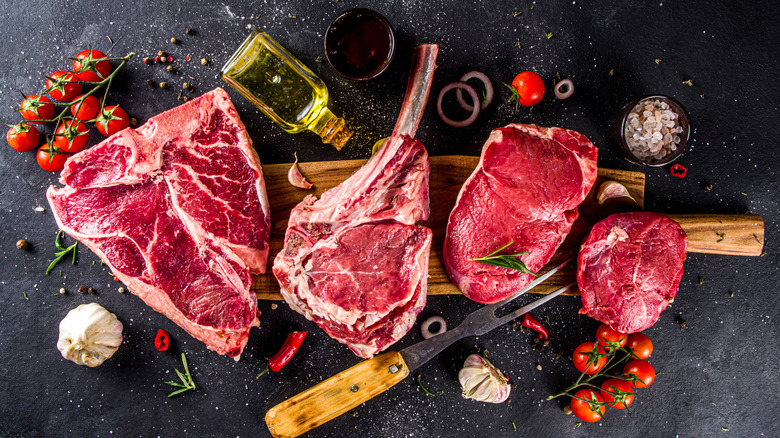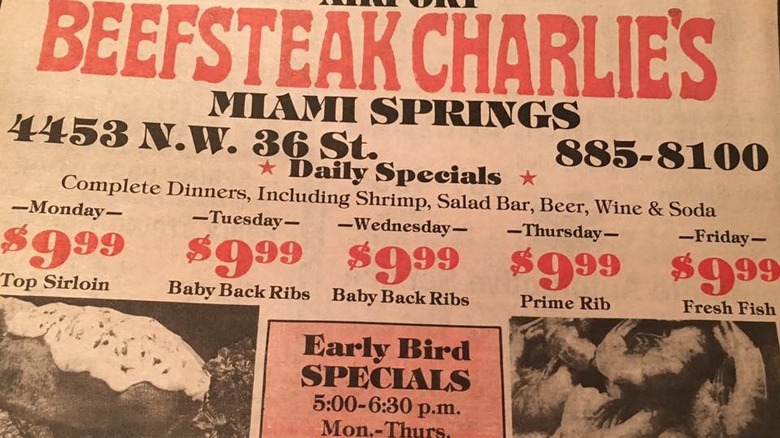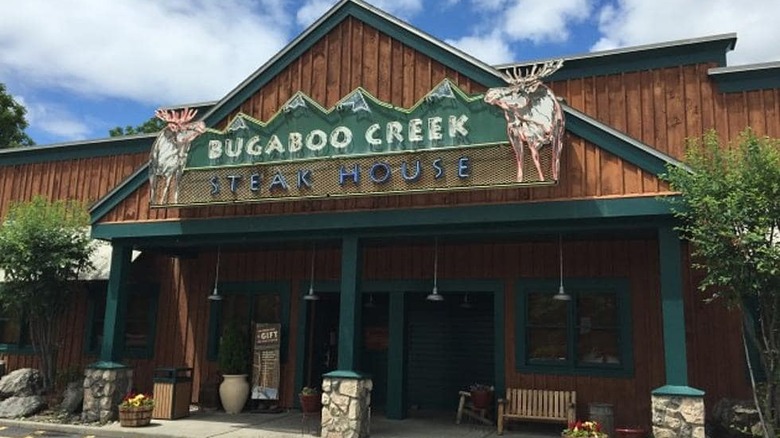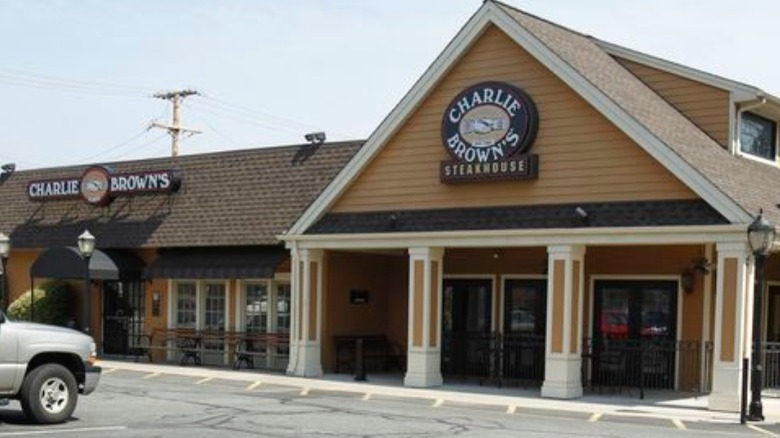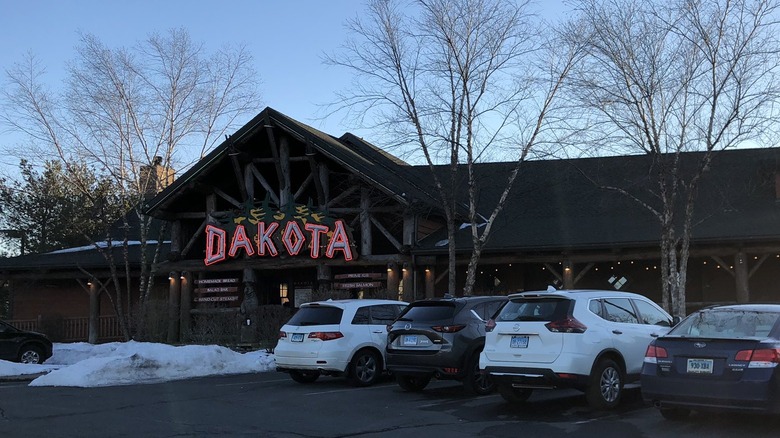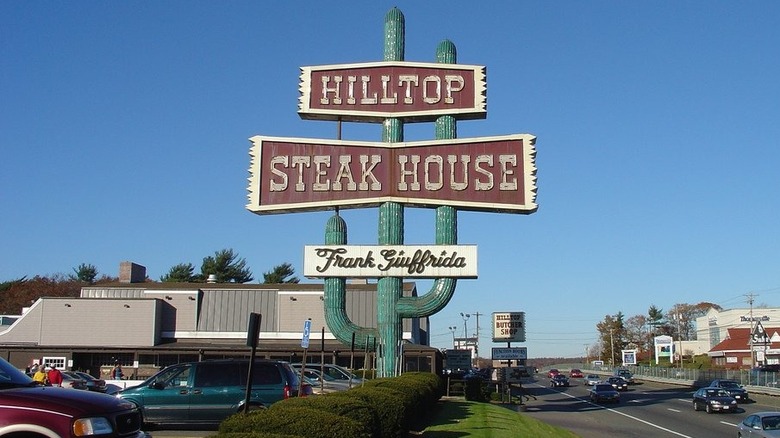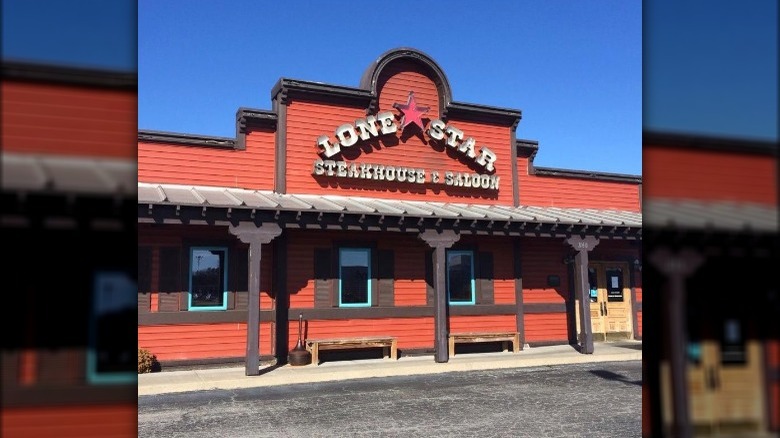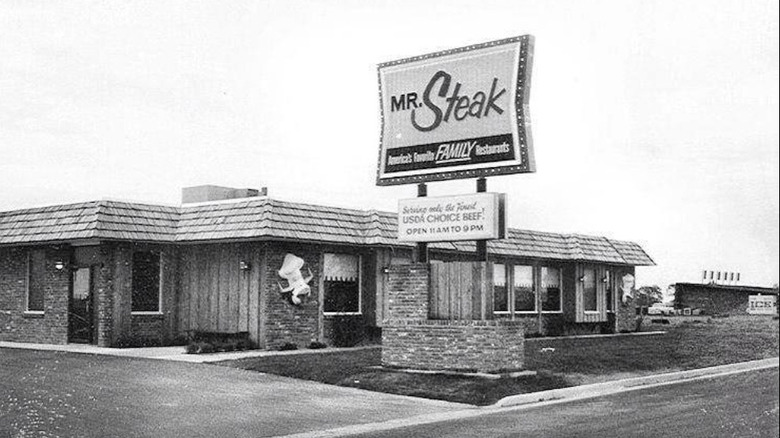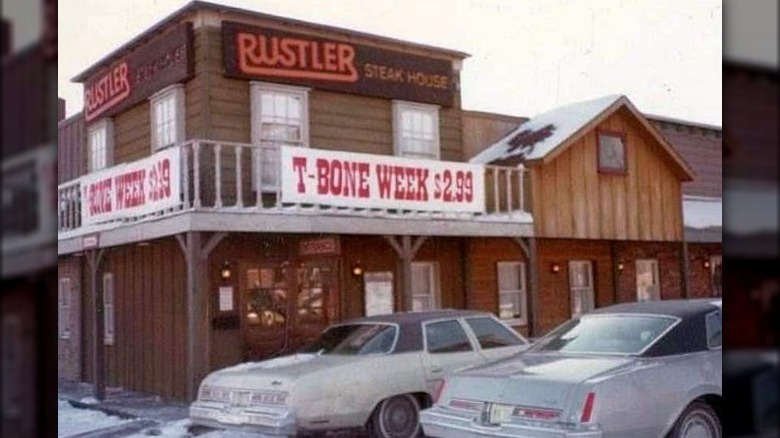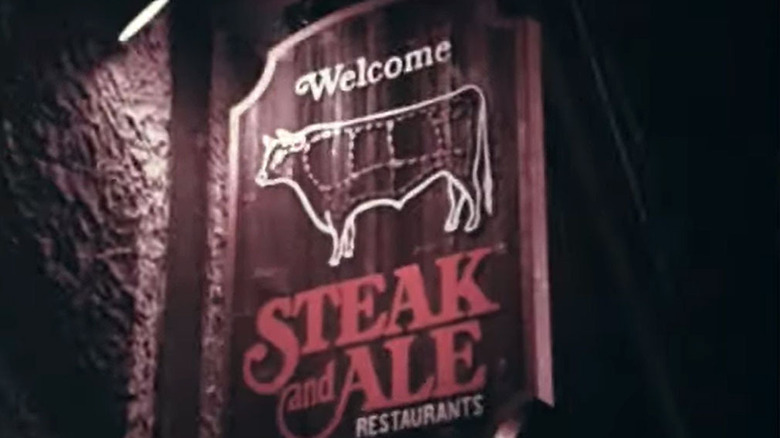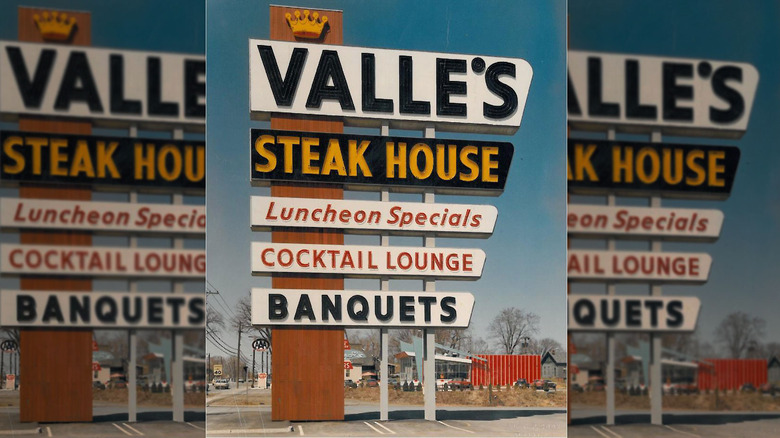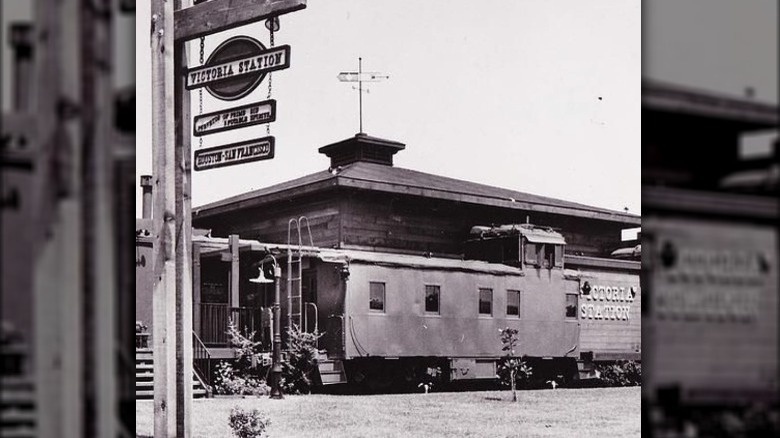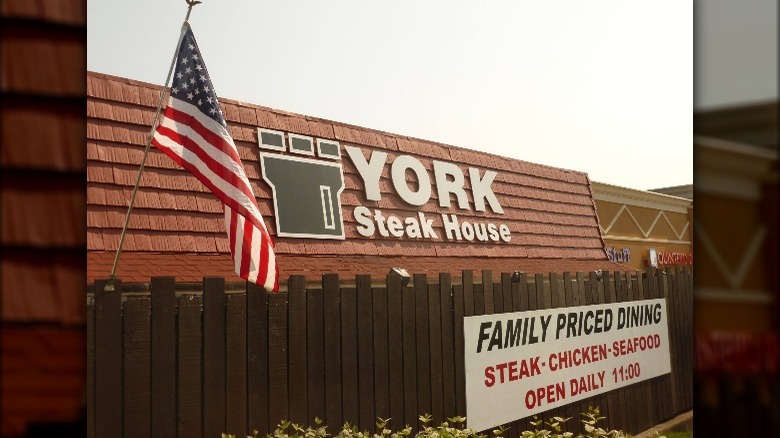Popular Steakhouses You'll Sadly Never Eat At Again
The steakhouse was once a foodie mecca, the pinnacle of both fine dining and family meals, and the ultimate meat lover's destination. If your parents were taking you out to a steakhouse for dinner, then you knew it must have been for a very special occasion. National steakhouse chains were once abundant, but rising prices and changing consumer habits have caused many of them to cut back on the number of locations, or close up shop altogether.
You will still find a few remaining strongholds in the world of steakhouses, such as Outback Steakhouse or LongHorn Steakhouse, but even those chains have struggled in recent years. On top of that, there are multiple steak-centric chains that sadly, will never welcome another customer again. This seems to be an alarming trend as of late with chains across multiple types of cuisine fading away. Many of these steakhouses had been in operation for decades, but economic hardships resulting in a dwindling bottom line cannot keep even the mightiest of meat meccas afloat.
As we'll discuss, many of the steakhouses listed below ultimately closed due to financial reasons, with many of the companies facing bankruptcy after shifts in the economy or changes in customer habits. If you were hoping to grab one more sirloin at any of the following steakhouses, you may be out of luck.
Beefsteak Charlie's
It was not long after the turn of the century before the first steakhouse on our list opened for business. Beefsteak Charlie's dates all the way back to 1914, when Charles W. Chessar leaned into his New York Morning Telegraph-dubbed nickname of "Beefsteak Charlie" and opened a sports bar that went just as heavy on the horse racing decor as it did on its steak sandwiches (via Tasting Table). The restaurant became a go-to spot for Manhattanites for years, even after it changed owners from its namesake founder in the 1930s according to The New York Times. Larry Ellman eventually bought the chain in the 1970s and began franchising Beefsteak Charlie's into the chain many of us remember today (via The Big Apple).
In 1985, Beefsteak Charlie's and its more than 50 restaurant locations along the East Coast were acquired by Bombay Palace Restaurants, Inc., By 1987, however, the beloved restaurant chain's restaurant empire was no more than a distant memory. During the acquisition, Bombay Palace Restaurants lost its accounting firm due to a discrepancy over reported renovation costs (via The New York Times).
Bugaboo Creek Steakhouse
If a tasty filet mignon is not enticing enough to drop by your local steakhouse, perhaps a talking animatronic moose head will convince you to take the family out for dinner. Wilderness-themed steakhouse chain Bugaboo Creek first opened its doors in the 1990s (via Journal Inquirer) and mainly stuck around the Northeast, offering a family-friendly atmosphere, serving up everyone's favorite cuts of steak while keeping customers entertained with a Rainforest Cafe-meets-log cabin vibes, including talking mounted moose and bison heads in the main dining rooms (via Delaware Business Now) and a talking pine tree that greeted guests (and induced nightmares, as one former customer recalls on Reddit). The unique environment that the restaurant offered made it a fun place to go out to eat, but even a talking moose could not save Bugaboo Creek from its ultimate demise.
After changing owners a few times, the company showed real signs of struggling in 2011, when bankruptcy threatened to close the 13 locations (via FSR Magazine). After a brief revitalization following the Chapter 11 proceedings in 2012, the chain experienced a brief period of decent business. But locations started closing off around 2016, including Stanton, Delaware restaurant (via Delaware Business Now). According to WOKQ, 2016 would be the last year any Bugaboo Creek locations remained open, and the chain has since closed.
Charlie Brown's Steakhouse
Around the time of Bugaboo Creek Steakhouse facing bankruptcy, another steakhouse was facing a similar demise. Charlie Brown's Steakhouse first opened in 1966 and grew to dozens of locations over several decades (via NJ101.5).
CB Holding Corp. (which at the time also owned the above-mentioned Bugaboo Creek Steakhouse) closed twenty Charlie Brown's Steakhouse restaurants in 2010 according to the San Diego Union-Tribune, which accounted for approximately one-third of the chain's locations. The company cited those locations were underperforming, and that decision seemed to help in keeping the remaining Charlie Brown's Steakhouses operating for several more years. In 2020, the COVID-19 pandemic caused the closure of most of the remaining steakhouses. The state of New Jersey began 2020 with 14 locations and ended that year with only a single remaining restaurant(via NJ.com). In the midst of these closures, the remaining fragments of the company went through a bit of a rebranding, with the Woodbury, New Jersey location reopened as Charlie Brown's Fresh Grill (via Bronx News 12). But its days of being a widely-available chain are long gone.
Dakota Steakhouse
Like several other steakhouses on this list, Dakota Steakhouse was primarily located in the Northeast region of the United States. This chain first opened in Pittsfield, Massachusetts in 1984 and eventually expanded to include other locations in Connecticut, New York, and Vermont (via Berkshire Eagle). Like Bugaboo Creek, Dakota featured a log cabin-esque theme, minus the animatronics. One of its unique features that originally kept customers coming back was its salad bar –- not necessarily the first thing you would think of when listing your favorite features of a steakhouse.
Beginning in the early 2010s, Dakota's parent company Pittsfield DWH LLC filed for Chapter 11 Bankruptcy in 2011, which resulted in a few select locations closing initially, including its Avon, Connecticut restaurant (via Patch.com). The company cited "economic pressures" related to tax debt that made continuing operations no longer viable, and by 2013, the remaining restaurants were abruptly closing (via Berkshire Eagle).
When the Latham, New York location closed in 2011, Times Union reported that the total estimated tax debt was between $1 million and $10 million. While the days of dining at a Dakota Steakhouse may be behind us, there are industry-leading steakhouses eyeing its former locations. According to Patch.com, LongHorn Steakhouse may soon find itself at the former Dakota location in Rocky Hill, Connecticut. So, if you are in the mood for a steak, you may still find it where Dakota Steakhouses once stood -– just under a different brand.
Hilltop Steakhouse
Bostonians will remember this beloved steakhouse that bit the dust. Hilltop Steakhouse opened in Saugus, Massachusetts in 1961 and became a bit of a local icon, at its peak drawing in over 3 million customers per year (via Patch.com). The restaurant had a road sign you could not miss, with its giant neon cactus looming in the distance, you may have thought you were in the middle of Route 66 rather than the middle of New England. That theme of the wild West continued after you went inside, with several of the dining rooms named after locations such as Sioux City, Dodge City, and Kansas City.
Eventually, Hilltop Steakhouse was able to expand, opening up additional locations in Massachusetts and Connecticut (via Hartford Courant). An offshoot butcher shop was also part of the Hilltop brand in Weymouth, Massachusetts, but that also closed following the nearby restaurant in 2013 (via The Patriot Ledger).
Though Patch notes in their article that the restaurant closed due to declining sales, there was another nail in the coffin that certainly did not help the restaurant's footing. Hilltop gained some local attention in 2006 when former employees sued, claiming that management had been taking portions of tips from servers. The location eventually closed, partly due to the negative attention brought on by the lawsuits (via Boston Magazine).
Lone Star Steakhouse & Saloon
Up next is Lone Star Steakhouse, which at one point was publicly owned and had over 250 units nationwide. In 2006 it began to show signs of financial struggle, and in order to remain in operation, it needed to go private (via Nation's Restaurant News).
The chain was acquired in 2006 for more than $600 million by a private equity firm, according to the Los Angeles Times. According to Nation's Restaurant News, the equity firm was an affiliate of Lone Star Funds, which also ran the successful Del Frisco's Double Eagle Steak House. There were some who were opposed to the merger, according to Seeking Alpha, citing that the price tag did not accurately reflect the company's true value. As a result of the change in management, previously purchased gift cards would not be accepted, and the Dundee, Michigan location urged cardholders to file a claim with bankruptcy court (via Yelp). This was followed by the abrupt closure of many Lone Star Steakhouse locations, according to Restaurant Business Online.
Though Lone Star Steakhouse is all but a faded memory in the United States, there is a location open in Guam if you ever find yourself traveling internationally and craving a steak (via Yelp).
Mr. Steak
Mr. Steak first opened in 1962 and quickly became a nationwide success. At one point, there were well over 200 locations across the United States, with television ads aplenty (via WFMK 99.1). The chain eventually suffered the same fate as the other steakhouses mentioned thus far –- dwindling sales and unhappy customers that were not too fond of the menu switching over to more salads and fish (we don't know about you, but when in Rome, one orders a steak, not a salad).
The first signs of trouble came about in the 1990s, when Mr. Steak faced bankruptcy according to Nation's Restaurant News. The chain was ultimately saved and intent on coming back like a phoenix from the ashes, but instead sold off its locations (according to WFMK, the Michigan locations were turned into Finley's). These days, one would have to turn to social media to reminisce about what it was like to dine at a Mr. Steak. There is even a Facebook group devoted solely to former employees of Mr. Steak restaurants, with members sharing their fond and not-so-fond memories of working at the chain.
Rustler Steak House
Rustler Steak House was opened in 1964 by Joe Campanella, a recently retired football player looking to shift gears and enter the restaurant industry (via Google Books). He operated the chain for several years, selling the chain to Gino's Inc., which then ran Rustler until 1982 when it changed hands again and was sold to Marriott (via The Washington Post).
The chain leaned heavily on a Western theme, with television advertisements featuring cowboys riding in on their mules to grab a bite to eat. In 1984, the chain decided to give its brand a bit of a facelift, swapping out the cowboy aesthetic for something a little more polished. The move was designed to re-position Rustler as an industry leader that could compete with the likes of their major competition at the time. The re-theming was done in an effort to increase the restaurant's dwindling profits, which, according to The Washington Post, was due in part to the recession in the 1970s and 1980s which resulted in the rising cost of feed and therefore the rising cost of beef.
While the efforts to breathe new life into Rustler paid off temporarily, the chain ultimately could not keep up with rising costs and shut down permanently in the 1980s.
Steak and Ale
Steak and Ale opened in 1966 and quickly became one of the first restaurant chains to embrace what would be known as casual dining, per Nation's Restaurant News. Opening around the same time as T.G.I. Friday's, Steak and Ale marketed itself by offering quality ingredients in an approachable, family-friendly environment. The chain prospered, with around 158 locations open in 1991, and around 280 corporate-owned restaurants at its peak. But the 2000s would be the decade when Steak and Ale faltered, and shortly before the chain closed, it was down to only 62 open locations (via Dallas Business Journal). But a Chapter 7 bankruptcy abruptly brought that number down to zero, ultimately shutting the chain down for good in 2008.
Ten years after the final Steak and Ale location closed, Bennigan's brought back three Steak and Ale dishes for a limited time, including its marinated sirloin Kensington Club along with two chicken dishes (via Nation's Restaurant News). The three "Steak and Ale Classics" are still featured on Bennigan's menu to this day. So while you cannot dine at a Steak and Ale anymore, the next time you are at a Bennigan's and you want to relive the glory days, keep an eye out for those classic meals on your menu.
Valle's Steak House
Another Northeast-based steakhouse chain that exists only in our memory is Valle's Steak House. Like Beefsteak Charlies, Valle's had been around for decades before going out of business, clocking in at nearly 70 years in operation. According to the Portland, Maine History Facebook page, the restaurant first appeared back in 1933 as a single cafe with just a few seats. The restaurant's success allowed owner Donald Valle to purchase a larger second location in 1936. It remained a Maine stronghold until the 1960s when it expanded into Massachusetts. The company was even able to go public on the New York Stock Exchange starting in 1968.
At its peak, Valle's Steakhouse had locations across New England as well as New York. But when Donald Vallee passed away in 1977, the family struggled to keep the business afloat. By 1991 the final chain location closed, one of them being located in Hartford, Connecticut (via Hartford Courant). An independently-run Valle's Steak House was able to continue serving customers for another nine years before closing permanently in 2000 (via Portland, Maine History).
Victoria Station
Although you will find some open locations for this next steakhouse over in Asia, it has completely vanished in North America. Victoria Steakhouse opened its first location in San Fransisco, California in 1969 by a trio of Cornell's School of Hotel and Restaurant Administration graduates according to The New York Times. The train-themed restaurant chain, which was known for utilizing old railroad boxcars as dining areas, went on to find great success in the 1970s, opening nearly 100 locations by 1978 according to a study filed with the Florida International University Hospitality Review. Success would not last much longer, however, as the company then began to experience a string of losses which the FIU study attributes to both a decline in customer interest and a result of expanding too quickly, both factors ultimately impacting its bottom line. Victoria Station filed for Chapter 11 bankruptcy in 1986, which resulted in the closure of most of its locations. However, one Victoria Station was able to remain open for nearly 30 more years.
According to The Salem News, the remaining Victoria Station restaurant in Salem, Massachusetts was the final U.S. location in operation when it abruptly closed in 2017. According to the article, the lease for the Salem location was up in November of 2017 and the business had not renewed it, though additional details beyond that were not disclosed at the time.
York Steak House
Co-founders Berndt Gros and Eddie Grayson opened the first York Steak House in Columbus, Ohio in 1966. Growth was steady for the first 10 years thanks to its success in opening locations around shopping malls, but its acquisition by General Mills Restaurant Group in 1976 was when the chain truly took off. After the acquisition, it grew to nearly 180 locations nationwide. While York Steak House once thrived off of mall foot traffic, it ultimately suffered its demise as the 1980s saw the rise of food courts with more budget-friendly dining options, leaving the steakhouse in the dust (via York Steak House). General Mills Restaurant Group sold off the locations in 1989, leaving only a few independently-run locations left in operation (via New Bedford Guide).
According to York Steak House's website, there is one independently-run York Steak House location in Columbus, Ohio where you can relive fond memories of its heyday. But the days of York Steak House as a chain establishment are long gone.
